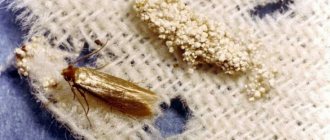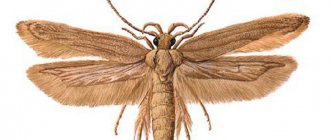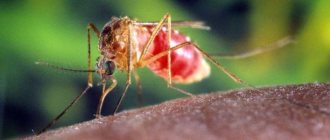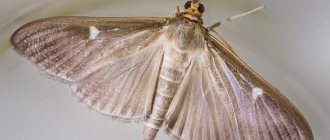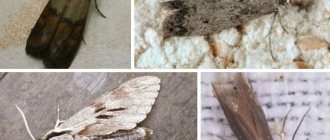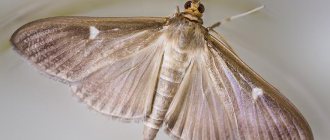Peculiarities
If dry bulk products are stored incorrectly, then you can be sure that sooner or later food moths will appear in the cereal.
Moreover, it is not the butterfly itself that causes harm; it does not feed on reserves, but the larva. There are several varieties of moth in cereals, which differ depending on their taste preferences. However, do not delude yourself: if a moth has destroyed one grain, it very easily and with appetite moves to another.
Moths in food.
A moth is an ordinary, inconspicuous small butterfly with gray wings. Most of all she loves rice and buckwheat groats, grain or flour. But the pest will happily feast on nuts, dried fruits, oatmeal, peas or even tea.
The flying individuals themselves do not live long, about 5-6 days. They are no longer interested in food, but only in water. She hides in dark places and lays eggs. After 7-10 days, voracious larvae emerge from the eggs, which cause maximum damage to the products.
Did you come across cereal with moths?
Not really
Description of the insect
The butterfly of the cereal (kitchen, grocery) moth has a gray-yellow or gray-brown color with a dark spotted pattern. The maximum length of the body is 1 centimeter, the wingspan is 1-1.6 centimeters. The insect flies slowly and chaotically, so it is easy to swat it with your hands.
The butterfly's mouthparts are not developed and it does not feed. Life expectancy is 5-7 days. In such a short period of time, the butterfly manages to lay 100-160 eggs. For successful reproduction, pests need warm temperatures (23-27 degrees), humidity of 50% and access to bulk products.
Fresh kitchen moth eggs are 0.5 millimeters long and white in color; later they turn yellow. After 1-2 weeks, larvae appear - the main culprits in the spoilage of cereals.
The body length of caterpillars varies between 0.3-1.5 centimeters. These are thin white worms with an orange dot on their head.
Kitchen moth larvae live and feed for 1-2 months, and then look for shelter (a crack in a cabinet, the bottom of a jar) to weave a cocoon and turn into a butterfly. The pupation process takes 2 weeks.
Harm from cereal moths
It would seem that if a butterfly does not bite or harm people, and is not a carrier of any infections, then why is it called a pest. Food moths leave larvae in cereals that feed on them. There they leave their excrement, as well as cocoons and dead flying individuals. Because of this, food becomes unusable.
Some housewives wonder whether it is possible to eat foods that contain moths.
No, it’s better not to do this and, in the event of a large-scale disaster, immediately throw away all bulk products with signs of moths. But if the first signs have just appeared, then you can remove the top layer of cereal, sort it out as much as possible and sift it to throw away all the remains of the pest. If there is anything left, dry it well in the oven.
Food moth caterpillars.
Harm from kitchen moths
Since the larvae do not feed on spoiled foods, they do not carry any dangerous viruses or bacteria. However, after a heavy meal, pests leave excrement, shed old skins, and secrete sticky threads.
Cereals, flour, nuts, dried fruits become unsuitable for human consumption. You have to throw away food contaminated with larvae and buy new food. In addition, the sight of worms in the kitchen is disgusting, and getting rid of them is psychologically unpleasant.
How to withdraw
It is very important to immediately move on to pest control as soon as its first signs are detected. If there are moths in the cereal, you must:
- Eliminate the breeding site of caterpillars, sift or sort the bulk grains by hand.
- If larvae are noticed, the groceries will have to be thrown away; they can pose a health hazard to both people and pets.
Proper storage is the key to food safety.
- For prevention, all cereals can be calcined on a dry sheet in the oven or frozen in the refrigerator for a couple of days.
- To clean up your closet, you need to remove everything from there, and then thoroughly wipe all the shelves and corners of the cabinets with clean water and vinegar or laundry soap.
An important condition is the correct storage of bulk products in sealed jars.
Let's start the fight
So, moths were found in cereals. Now we’ll figure out how to get rid of the pest. This will require a whole range of measures that together will help restore cleanliness:
- Full inspection and refurbishment. If a cereal pest was found in the kitchen, you will have to get serious about cleaning. Open all the cabinets, take out food from the most hidden shelves. This is a chance to kill three birds with one stone: do general cleaning, check expiration dates and find moths in cereals. How to get rid of it (see photo in our article) in the shortest possible time? Throw away any spoiled food in which larvae are found.
- Doubts are raised by those packages of cereals that at first glance look uncontaminated, but were stored unsealed. In this case, it is better to throw them away too. They may contain insect eggs that you cannot see with the naked eye.
- Now, since the food has left its place anyway, you can sanitize the kitchen. All remaining cereals must be packed again into hermetically sealed containers, and cabinets and shelves must be washed. After such cleaning, entering the kitchen is a pleasure.
Folk remedies
Folk remedies are effective and safe for people and pets. That is why housewives resort to them first. Here are several ways to get rid of cereal moths.
| Strawberry soap and lemon or orange peels | As you know, citrus peels emit a bright aroma that moths cannot tolerate. This repellent will reliably protect things and textiles from uninvited guests and scent items in the closet. |
| Black and allspice, tobacco, cloves, rosemary | The spicy smell of allspice and other seasonings effectively repels moths and creates an unfavorable environment for breeding offspring. |
| Laundry soap | Potato and clothes moths cannot live normally and produce offspring if laundry soap is nearby. |
| Vinegar and garlic | Diluted vinegar is often used to treat cabinets for preventive purposes. Placing garlic cloves in boxes works the same way. Butterflies cannot tolerate the persistent, aromatic root vegetable. |
| Fir oil | A study of essential oils showed that fir oil was effective in the fight against domestic insects. Apply the oil to a cotton pad and wipe the surfaces where traces of moths have been noticed. |
| Caucasian chamomile | This product is used in dry form - sachets of several grams are made and laid out around the apartment. |
| Chestnuts | Dried chestnuts are used to layer clothes and home textiles, thus preventing the appearance of butterflies. |
| Houseplants coleus (nettle) and geranium (pelargonium) | These indoor flowers have a bright aroma that insects cannot tolerate. Flowers placed around the room will repel insects and will not provide comfort for reproduction. |
| Lavender | The fastest way to get rid of moths and other pests in the house is lavender and its oil. It has long been known that sprigs should be kept in all wardrobes, and lavender oil should also be used on surfaces and upholstered furniture. |
| Sagebrush | The smell of wormwood twigs has an unusual property: it can disorient adult moths in space, thus the life cycle is disrupted and the pests disappear. |
| Newspapers | Printing ink is known to repel insects. Thus, things arranged with newspapers will remain untouched by harmful insects. |
| Vinegar | To treat surfaces with vinegar, you need to heat two tablespoons, then place the hot liquid in a cabinet for about 10 minutes. This time is enough to kill both larvae and adults with acid vapor. |
Appearance
This pest looks very inconspicuous, as it has a discreet color and small size. When the butterfly's wings are folded, the body length reaches 8 mm, and in this position it is very difficult to notice even with a direct look, since it looks more like a small protrusion than an insect.
Important! It is necessary to recognize the type of moth you encounter, since all adult individuals are very similar in appearance, only their color distinguishes them. To determine who you are dealing with, you should pay attention to where the butterflies are flying - in the kitchen or near the wardrobe.
Please note: there are also several types of food pests, and their colors can vary.
Being at the caterpillar stage, the pest has a milky white or slightly yellowish color, and its body length reaches 12-14 mm. The sparse hair has several short bristles. The larva parasitizes in the rump until the moment of pupation, and when this period begins, it crawls out of its nesting place and it is already quite difficult not to notice it.
Despite the fact that an adult moth has wings, it flies very poorly, therefore, like a caterpillar, it prefers to lead a secretive lifestyle. But unlike young individuals, butterflies are not able to destroy reserves, since their oral apparatus is atrophied at this stage. The main pests are the larvae. You will find more information about the life cycle, development and behavior of moths in other articles on our website. For example, if you are interested in what foods and wardrobe items this pest likes to spoil most, then read the article: What does the moth that lives in a human home eat?
Store funds
Store-bought products are effective, but you need to be careful with them, because they can harm human health. They are not recommended for use on cereals.
Traps
Moth trap.
There are special insect traps on sale. They are safe for food because they do not emit toxic substances. It contains pheromones that are extremely attractive to moths.
The butterfly flies to the smell and lands on a sticky surface, from which it is no longer possible to escape. On average, one trap lasts for 3-4 months. The main thing is that it can be placed near food products.
Chemicals
There are aerosols, adhesive tapes or special dry powders, which, according to the instructions, must be used by spraying or installing where pest activity has been noticed. The most effective are Armol, Raid, Raptor or Clean House.
Anti-moth preparations.
Chemicals
Stores sell insect traps. Moths that settle in cereals are not a type of pest that requires the use of strong insecticides. Since the insect is found in products, the use of chemicals is dangerous for humans by poisoning.
It is better to focus your attention on means that mechanically remove pests - sticky tapes. They are treated with a special substance that attracts moths. They can be glued in cabinets along the walls.
The moth sticks to the tape and can no longer move. After this, the tapes can simply be thrown away along with the adhering pests.
The cereal “guest” belongs to the same family as the fruit and clothes one. Her only food preference is cereals, grains and flour.
Prevention measures
- It is best not to buy food supplies of bulk products in large quantities, because this is extremely attractive to moths. However, if you still have to make supplies, then you need to purchase them in trusted stores. It happens that even on an industrial scale, moths can severely damage grocery supplies.
- If there is a suspicion that the products have been under the influence of a pest and may be contaminated, then it is better to bake them or leave them in the freezer for a couple of days. Food products should be stored in tightly closed jars. These can be metal or plastic containers.
- It is important to regularly wet clean all kitchen elements. This applies to lockers. All corners, shelves and doors need to be thoroughly washed. If there is ventilation in the kitchen, then the grilles should have mosquito nets. This way you can protect your kitchen from moths, as well as from cockroaches, bedbugs and other insects.
It is best not to create favorable conditions for moths and not to store dried fruits, groceries and tea nearby.
Preventing the appearance of cereal moths in the house
It’s a shame to constantly throw away food, so it’s better to prevent insect pests from appearing in the kitchen. Follow simple rules that will help you forget about cereal moths for a long time.
- Do not buy cheap cereals by weight. Manufacturers often try to sell contaminated products at bargain prices.
- Check flour, cereals, and muesli immediately after purchase for the presence of eggs and larvae.
- Store groceries in glass or plastic containers with tight-fitting lids. Please note that kitchen moth larvae can bite through a plastic bag. Muesli is at high risk, so immediately after purchasing, place this product in the refrigerator.
- In a jar of cereal or flour, place cloves of garlic or orange peels, the aromas of which insects cannot tolerate. The larvae simply will not be able to hatch from the eggs.
- Place herbs or foods that repel butterflies on the shelves of your kitchen cabinets. Folk remedies against kitchen moths include the following:
- lavender;
- mint;
- tobacco;
- black pepper;
- Bay leaf;
- carnation;
- garlic;
- citrus zest.
We also recommend that you grow (buy) geraniums and place the pot in the kitchen on the windowsill. The plant will delight you with lush pink flowers and at the same time repel food moth butterflies, mosquitoes and midges.
Bottom line
The appearance of moths in bulk food products is, of course, unpleasant, but not critical. This can be prevented using simple and accessible preventive measures. If the moment is missed and you have to deal with insects that have already appeared, then you will need to start with gentle measures that will be safe for food and human health. Simple, cheap and effective means of control are always at hand.
Previous
MolesWhat moths are afraid of: getting rid of pests in 10 different ways
Next
Moth Moth trap: review of manufacturers and DIY production
Features of wrestling
Clothes moths can be killed using toxic repellents and other potent agents. It’s more difficult with food pests. It is forbidden to treat cereals and flour with pesticides ; it is also undesirable to use food moth repellent near kitchen surfaces, dishes and household heating appliances.
This is why universal preparations for indoor moths, skin beetles and other pests are not suitable. Then how to deal with kitchen moths?
In stores you need to look for products designed to destroy food pests specifically .
Favorite places
There are places and foods in the kitchen that insects really like. Such places include:
Various cereals. The insect prefers cereals such as buckwheat, corn, rice, rye, oats, legumes and others. Sometimes it is found in small, portioned bags of cereals and cereals.- Dried fruits.
- If this insect has been bothering you for a long time, most likely they have settled in hard-to-reach places, for example: under a windowsill, under or behind furniture, in equipment that has been inoperative for a long time.
- There are also foods that moths do not eat, but live in containers with them (soda, salt), for this reason, when cleaning the kitchen, pay attention to these foods.
Under no circumstances should you become hysterical or panic when you find a pest in your kitchen. Gather your strength into a fist and act.
Reasons for appearance
This question is relevant for many housewives. Many of them shift the blame for the appearance of these insects onto themselves. However, there is no need to think so, because the housewife is able to take care of her home and her kitchen. In many cases, when buying products in stores, especially if there are discounts on the products, they are already in an infested state and contain biological material for moths to reproduce in your apartment.
Dishonest owners of large stores and wholesale warehouses do not monitor the storage conditions of certain goods, as a result of which such pests breed in warehouses.
Other sources of potential infection include ventilation shafts and poor-quality windows, from which the pest enters the house and multiplies indoors. For example, if your neighbors already have a problem with moths , most likely you should expect “unexpected guests” in your apartment.
Routes of infection
The best solution to a problem is its prevention. This is an indisputable fact, which is why it is important to know where moths in cereals come from. How to get rid of an insect is the second question; it is better not to allow it into your home at all. Unfortunately, this is more difficult to accomplish than it seems at first glance. The fact is that many food products become contaminated during production. This occurs due to improper processing, violation of storage standards, etc. In the warehouse and store, temperature conditions may be unsuitable for the development of larvae, so they are waiting in the wings.
At home, we usually store dry food in closed cabinets. It is dark and warm there - ideal conditions for insects to begin to actively reproduce. The population is increasing sharply. The larvae chew through the bags and infect everything within reach. Sometimes moths can arrive from neighbors, but this happens extremely rarely. Therefore, you should not think badly about the people who live nearby. Now you know where moths in cereals come from. We still have to figure out how to get rid of it.
How to get rid of food moths in an apartment
Fighting parasites is a rather troublesome process. To get rid of food moths in an apartment forever, all control methods must be used in combination. You should find the source of infection, destroy it, throw away all spoiled groceries and process products that may be contaminated. There are five ways to minimize harm and exterminate the pest.
- Throw away contaminated food. Check all groceries for pests. If you are in doubt whether a product is affected or not, it is better to throw it away than to torment yourself with an eternal struggle with moths. Be sure to check the packaged products - polyethylene is not a hindrance for the larvae. Do the washing up. Using laundry soap, thoroughly rinse all containers in which the affected cereal was stored, including adjacent jars. Clean out the cabinets. Wipe doors and shelves with vinegar; its pungent smell will repel moths. If the infection was global, treat the interior walls of the furniture with special aerosols. Process the cereal and cans. Calcine the cereals in the oven at 80°C, or put the cans of grain in the freezer for three days. If there is a sharp change in temperature, the parasites will die. Pour into clean containers. After freezing or reheating, transfer food to new containers with tight lids. Place a clove of garlic in each container to repel parasites.
To avoid causing moths to appear in your apartment, do not leave fruits and berries on the kitchen table. Also, do not stock up on large amounts of groceries for future use.
Folk remedies
Folk remedies have proven themselves well as a “fighter” against moths. They have a pungent odor that repels the pest, but does not rid the food of larvae.
Garlic. Place a couple of cloves of peeled garlic in the container with the cereal. The female will not like the acrid amber, and she will not want to lay eggs. Garlic does not affect the taste of food. Laundry soap. Grate the soap and mix with water. Wash all interior surfaces of cabinets, then rinse and dry. Vinegar/lemon juice. Wipe the walls and shelves of cabinets with vinegar, and use a brush for hard-to-reach crevices. Treat with the solution after pre-washing the furniture with laundry soap. Lavender. Parasites cannot tolerate the aroma of this plant. Place a couple of branches in the chest of drawers where the cereal jars are. The products will be protected. Citrus. The smell of oranges and grapefruits repels moths. Place citrus peels on cabinet shelves or in a kitchen drawer. Bay leaf. Cover all groceries with bay leaves - adults do not like this peculiar smell. Tobacco. He is afraid of food moths and the smell of tobacco. Place a few cigarettes on the shelves in your closets. This will scare away the female and she will not lay eggs. Camphor. The smell of camphor alcohol will remove the parasite from your kitchen for a long time. Dampen a cotton pad with the solution and wipe the inside walls of the cabinet with it.
Remember that treatment with folk remedies will only temporarily protect groceries from pests. Over time, the larvae will develop immunity, and methods of prevention and protection will need to be changed.
Chemicals
When the focus of infestation is strong, professional food moth repellents are needed. Chemical sprays and aerosols are considered effective insecticides on the Russian market.
"Antimol." The spray is designed for treating kitchen cabinets. After spraying, the effect lasts for a year. Destroys moths of any kind. "Raptor". The aerosol helps get rid of not only butterflies, but also larvae. Raptor against food moths is valid for one year. "Combat". Copes with all types of moths. The spray is sprayed on furniture and in the corners of the kitchen; it is absolutely safe for pets.
The aerosol helps create a protective barrier and kill pests. It must be used strictly in accordance with the instructions. After treatment, ventilate the room well and thoroughly rinse surfaces that may have been exposed to the spray. Other drugs also help control pests.
Trap for food moths. The Aeroxon trap, a special odorless product, has proven itself well for catching adult specimens. It is filled with pheromones that attract male food moths. Males fly to the sticky surface, where they die, stopping further reproduction. Sticky traps are non-toxic and absolutely safe for human health. The cost in retail stores fluctuates around 200 rubles (data as of January 2021). Repellents. These are special plates, tablets and briquettes. They contain naphthalene, the pungent odor of which repels food moths. The repellent does not destroy the pest, but facilitates its relocation to another territory.
The use of insecticides in residential buildings is not recommended. The high toxicity of these products poses a threat to humans and domestic animals.



